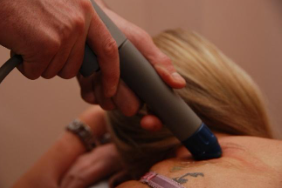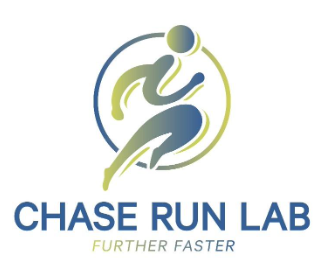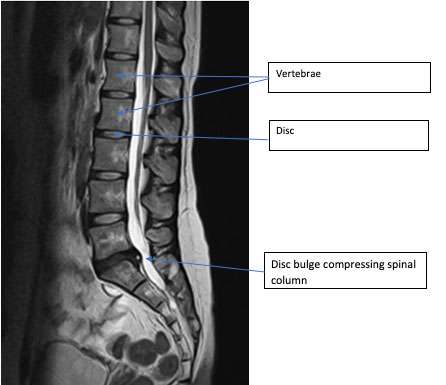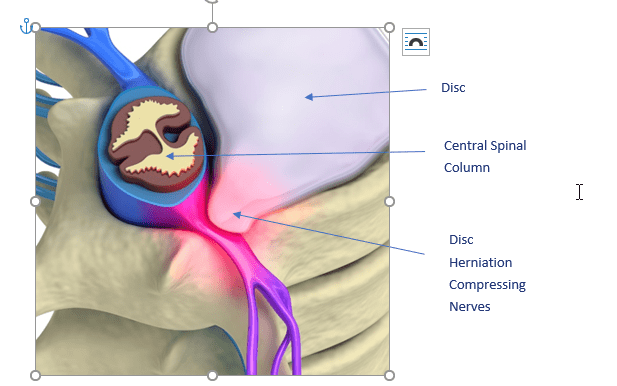Radial shockwave provides a non-invasive gentle treatment, designed to alleviate pain and speed up recovery from injury. Despite what the name might suggest, it does not involve any kind of electrical shock treatment. Instead, it sends low energy pressure waves into damaged tissues to stimulate the body’s natural repair process, speeding up recovery and reducing inflammation.
A common concern is that treatment will be painful and the answer is reassuringly no. In fact, most clients describe the sensation as being similar to a gentle tapping on the skin.
This non-invasive treatment is very effective in treating problems such as:
- Plantar Fasciitis
- Calcified tendonitis
- Chronic tendon problems (tendinopathies)
- Achilles
- Knee
- Elbow
- Shoulder - Muscle tightness
- Legs
- Buttocks
- Spine
- Arms
We have made shockwave a standard part of the treatment we offer and have kept to our ethos of providing the best value treatment we could by providing shockwave at no extra charge. This is something we still do today and our clients love the fact that is an integral part of our hands on treatment capability.
or call 01889 881488
Committed to provide the best treatment value to you
Our clients love shockwave and we also found that they liked a device called a V-ACTOR, which is a very powerful vibrational therapy tool, the power coming from the shockwave internals. Understandably our V-ACTOR has been sought after but only having one on site has restricted access at times.
Our major focus, however, has been on the shockwave treatment and over the years as demand grew we added more shockwave machines, eventually having four.
Top Quality Treatment. Available to you at no extra cost

But our ethos remains the same – we want to provide the best treatment we can and that means the best hands on treatment, and for us that has to include both shockwave and vibrational therapy. Thus, we have taken the decision to add two more high quality shockwaves and both include the much loved V-ACTOR vibrational therapy. They are already on site and are available to you at no extra cost should you need it.
Having six shockwaves on site is perhaps a sign of our commitment to provide the best treatment value to you.
Jean, Erica & Charlotte will be happy to help
or call 01889 881488
Nicky Snazell Clinic, which has been providing biomechanical analysis for a few years, has stepped up to a higher level and introduced a new arm to it’s already formidable capability.
We introduce the Chase Run Lab.

Providing you with access to highly qualified therapists who really understand gait and biomechanics. Supported by Footscan technology, we can provide you with a detailed understanding of your current problems and how to improve. If you want to reduce pain and the risk of injury, we can help.
Most running injuries are caused by chronic overload, which will eventually lead to recurring pain and an increased risk of injury which ends up with you having to restrict or even stop your running.
We provide expert knowledge from therapists who have worked extensively with all types of runners, from casual to elite. This requires a detailed understanding of how to diagnose your current running technique including
- 2D Gait Analysis
- Stride patterns
- Running form
- Impulse pressure
- Ground contact time
- Posture
- Strength assessment
- Pelvis biomechanics
We have upgraded our treadmill and added Footscan technology and moved to providing Phits orthotics, the worlds first 3D printed orthotics.
Or call 01889 881488
Who would benefit from our help?
We can provide expert Gait Analysis and help those
- wanting to prepare properly for an upcoming marathon
- who suffer recurring injury problems
- want to improve their running technique and efficiency
- wanting to prepare for a specific goal.
You don’t have to be a runner to obtain big benefits. It applies equally to many sports, including those that don’t even involve running:
- Football
- Rugby
- Hockey
- Racquet sports
- Golf
- Walking
Once we have you properly assessed we will provide you with a personal report along with our advice on the best course of action, whatever your needs.
Our advice might be a need for physiotherapy to correct any underlying causal factors, such as incorrect pelvis function, or muscle tightness caused by neurological issues. It may also suggest you would benefit from bespoke orthotics and we are proud to offer state of the art Footscan technology which links directly to Phits, the worlds first 3D printed manufacturer.
As a special, introductory offer, we will supply you with your own Phits 3D printed orthotics for just £250. That’s a £50 saving!
Our Footscan software can show you the benefits of the orthotics on the screen, so that you will have a clear understanding of exactly how they will help you.
Phits are the preferred orthotics for many elite athletes and have been worn by every female winner of the London Marathon for the last 10 years. So you know you will be getting the best.
If you are wanting to prepare for a specific goal, then we can help:
- whether it be joining the local park run or climbing Kilamanjaro
- or you keep getting held back by the same recurring injury
- or want to be coached in readiness for an upcoming marathon
- or if you are an experienced runner wanting to improve your efficiency
Or call 01889 881488 we can help
Right now the country is in turbulent waters and we need to make sure we have a strong arm on our rudder, to make sure we reach calmer waters for the long run.
Most people realise that the country is going through some turbulent times and many businesses have had to downsize or in worst cases cease trading. The last four months of 2023 was a particularly testing period, but the good news is that the new year has started with much more confidence and we, along with many other businesses are seeing signs of better times.
Whilst the trend may be upwards and improving, the fact is that the UK is not yet out of hot water and it would be equivalent to a head in the sand approach to assume only rosy times ahead.
At Nicky Snazell Clinic we have built a very good team, the best we have ever had. We continue to invest heavily in both in their continuous training and in the up to date technology support available to them. Our confidence in the team has allowed us the opportunity to redistribute our efforts so that when the next downturn comes, we are in a much more robust position to deal with it.
To achieve this, it is vital that we place more effort on working on the business rather than in the business, otherwise we will be like a rudderless ship in stormy waters. This has required us to take the decision to reduce Nicky’s hours treating clients, so that she can work alongside Alan to bolster our marketing and management efforts. Our aim is to make significant changes for the better. Creating positive change, while maintaining existing practices, demands extraordinary effort and we approach this task with total confidence and commitment to success.
The change in Nicky’s treatment hours will be complete by the week starting 11th March, when she will be treating clients on Mondays and Wednesdays only. This will inevitably increase the waiting time to see Nicky, but the good news is that she has a great team, in which she, and David, have already and continue to spend many hours training every week. Should the waiting time be longer than you can cope with to see Nicky, now is the time to consider discussing with Nicky who would be the ideal backup. Remember, of course, that Nicky’s team have had the opportunity to work alongside Nicky and David. and have had intensive training from Nicky and David, an opportunity which will continue into the future. Other clinics simply don’t have this unique advantage.
For those of you who are Wellness or Maintenance clients, these changes will make little difference, as you have the distinct advantage of booking well ahead. For those who are not on a preventative option, remember that prevention is always better than cure, so maybe now is the time to move up to a more proactive approach to your health.
We ask for your understanding in these turbulent times. The reality is that this change, while perhaps causing some short term pain, will in the long run prove to be a massive benefit to you in terms of access to treatment capability that you will find very difficult to get elsewhere.
Ultimately, our goal is to provide the best treatment possible in the most welcoming and friendly environment, so that you feel safe and confident from the first day you walk through our door. Our team are more than capable of providing exactly that and this change will ensure that this will continue well into the future.
Warm wishes
Nicky & Alan
At some point in the not too distant future, some of the clients sitting in the waiting room with you might be paying half as much as you are for their treatment and every other treatment they have.
And it won’t have cost them a penny!
Their Secret
They will be some of our referral Ambassadors. To become an Ambassador is very simple. All you have to do is refer 3 new qualifying clients within 12 months. That’s it! (When we first launched our Ambassador Club, we asked for 3 referrals in 6 months. We had quite a lot of feedback from clients who were keen to refer, but found 6 months too little time to get 3 quality referrals. So we listened and we have increased the time limit to 12 months to help)
If you come for treatment every month for a year, the saving to you could be a colossal 5 times more than not being an Ambassador!
Membership will last until the end of the same month the following year. For example, if you were to become an Ambassador in June 2025, your membership would last until the end of June 2026. Refer 3 more qualifying clients in that first year and you will extend your membership for yet another year to June 2027.

Keep referring 3 new qualifying clients each year, and you will stay an Ambassador until you stop.
What this means is that you have the option of paying half price for treatment for as long as you want.
The value our clinic offers, our clients tell us, is already outstanding, not only because of our specialist knowledge, but also because of the ongoing investment we continue to make to ensure we maintain our position of being ahead of the curve. Simply put, we have advanced technology that most others can’t offer.
At half price this makes what we offer almost unmatchable.
Here is another big benefit to you. – Many clients have told us that they would have really benefited from an hour appointment, but their finances didn’t stretch that far. As an Ambassador, you could book an hour EVERY TIME and only pay the price for half an hour
We can even help you refer, as we have great referral cards for you to hand out. Ask at reception when you need more.
Now, it may be that you feel unable to refer as many as 3 new clients in a year. Well, don’t feel left out, as we still have an amazing offer for you. If you refer a qualifying client to us, we will give you a voucher worth £20 off your next treatment. (rules apply – see below). Refer a second new client and we will give you another voucher worth another £20. If you are unable to reach 3 referrals within 12 months, but keep on referring, we will continue to give you a £20 voucher for each referral.

But if you are able to refer 3 new qualifying clients to us within 12 months, then we will not give you a £20 voucher for the third referral. Instead, we are going to give you a lot, lot more! We are going to enrol you as a member of our Ambassadors Club. Once a member, you will get half price treatment for the next 12 months. And that’s a much bigger saving than you might think it is!
If you come for treatment every month for the next year, you could save on average nearly £300, that’s 5 times more!
Once you become an Ambassador and you get the benefit of half price treatment for the next year, you are not going to want to give up such a fantastic offer, and we have made it easy to keep your Ambassador membership. Just refer 3 more every 12 months to continue your membership for another year.
Let’s explain again to make this clear:
- Refer 3 new qualifying clients in a 12 month period to become an
- As an Ambassador, you will be entitled to half price treatment for the next year (rules apply)
- Refer 3 more in your first year of being an Ambassador and you will remain an Ambassador for a second year.
- Keep on referring 3 new clients every year of membership to extend your membership by another year.
If You Are In Pain We Can Help
Half Price Helps Even More!
Call 01889 881488
TERMS - Once you become an Ambassador, you will get the 50% Ambassador discount instead of the £20 referral discount. Referred clients need to attend an assessment plus two follow ups to qualify. The maximum treatments per year for the Ambassador half price offer is 12. No discounts are redeemable for cash. Discounts are non transferable. Management reserves the right to cancel or modify the offer without notice.

My next book is going to be very important to me. It will probably be my last and it is thus tremendously important to me that I write a book as good as it can be, clearly communicating my message not only to the public, but also those in my profession, whatever their age. I’ve realised that I have a much better chance of achieving this goal, if I recruit the help of my target audience, by getting them on board right at the beginning.
If you think you would like to help, then read on
After writing five books, I’ve recognised for many years that I’ve never truly expressed the purpose of my life’s work. One significant reason is that I’ve always been treated as being a bit unconventional, a bit weird even, and I was fearful that if I opened up completely, I would be exorcised from my profession. In my younger days, my professional body dictated very strict guidelines and most certainly would not have approved of my drive to seek treatment solutions way beyond their boundaries.
In the past I’ve been too scared to lift my head even further above the parapet in fear of being struck off. Yet at the same time, I’m proud that I’ve had the strength to not take the easy path by following the crowd. It was, after all, an experience as a young child where I witnessed the failure of Western medicine to prevent my mother from suffering years of excruciating back pain, which acted as the catalyst to send me on an alternative path. I reasoned at the time that if our Western medicine could not help, then it was only logical to look elsewhere, outside the box.
As I approach the twilight years of my working career, my fear of speaking more openly has subsided, as I really have very little to lose. Much more importantly, there will be others, much younger than I, thirsty to learn, just like I once was, and it would be a terrible waste to never transfer the knowledge and understanding I have worked so hard to learn.
It is thus tremendously important to me that I write a book as good as it can be, clearly communicating my message not only to the public, but also those in my profession, whatever their age. I have realised that I have a much better chance of achieving this goal if I recruit the help of my target audience by getting them on board right at the beginning.
What is my book about?
I have learnt that the ability to heal successfully requires so much more than just physical treatment. Oh so often patients have no understanding of why they suffer ongoing pain, both physical and emotional and nothing seems to help. Most carry emotions and memories buried deep within which bubble up throughout life, the very source of their chronic pain.
From my life’s studies, I have learnt how to use a healing presence, which is so much more than any one particular technique, to overcome those pain antagonists buried within.
I will take you on a journey, via a series of interconnected stories, each based on true patient interactions, and which together slowly uncover how I treat suffering souls.
I have an understanding where I want you to reach and the journey itself needs to be one of providing knowledge and understanding in an enjoyable way. If I can achieve that, then I believe my message is much more likely to be successfully communicated. In my own work I have experienced countless examples of achieving far better outcomes with a combination of conventional treatment and a healing presence. My hope is that this book will allow many others to provide and receive the same benefits.
Your Part
As I release parts of my book, still in draft form, to ‘Nicky’s Book Group’ in Facebook, I hope it will encourage constructive feedback from you, with suggestions on how to improve it, making the message clearer and a more enjoyable read.
If you feel that this is something that you would like to be involved with and to actively contribute, then I would be delighted to welcome you.
Please connect to my clinic's Facebook page with this link:
https://www.facebook.com/groups/1540317436702804/
and request membership to join ‘Nicky’s Book Group’
Thank you for reading this, and I hope to welcome you to my book group soon.
Warm wishes
Nicky Snazell
We have long known that we have both a fight or flight system to deal with danger and an opposing system which calms us and relaxes us when not in danger, called the sympathetic and parasympathetic systems respectively.
However, we have now learnt there is a third system of response to our environment, buried deeply in our ancient heritage. This system switches on when we believe we cannot overcome the danger in front of us. It shuts us down, immobilises our body and prevents meaningful communication. It can be triggered by something happening at that moment, or by a resurfacing memory of a traumatic event earlier in life, possibly all the way back to childhood.
For the therapist this immobilisation means effective communication with the patient is all but halted and it is vital that initially a softer, slower approach is adopted before considering more conventional western medical techniques.
I call this the softer arts of medicine.
Click here to learn more.
Our ancient medical healers worked artistically on an energy system of healing. This included such skills as acupuncture, acupressure, body work like myofascial release, massage, reflexology, shamanic reiki and shiatzu. I like to describe this way of clinical practice as using the softer arts of medicine, where we silently and truly listen to the patient and treat through the body, heart and mind. This approach recognises that the mind receives information about how we feel through the body and through our heart. Equally, when we are experiencing strong emotions, we send messages from the mind, back to the heart and body.
In terms of modern Physiology there are three systems of physical response to our environment.
In other species that often saves lives. For example, if a small rabbit is in the jaws of a large cat and the cat believes the rabbit is dead, instinct tells the predator to drop the dead meat. When the predator disappears, the little rabbit can shake and get up and get out of danger.
When a patient has been traumatised in the past, there arestrong emotions that can be triggered by a therapist’s touch, or even just tone of voice, simply by memory association. Whenthat inner child within us feels fear, like sitting in front of a doctor, therapist or surgeon, we can feel so powerless that our ancient, third system can kick in. We shut down, no longer able to listen or remember anything being said.
What may appear to be a straightforward sports injury or back strain can never be further from the truth
When dealing with those who have been through trauma as a child, a war, or perhaps have witnessed a terrible accident, the softer arts are so useful in gently enabling the person to feel safe. A journey with the softer therapy arts can get us ready for western approaches of stronger physiotherapy exercises,surgical intervention, or stronger medical drugs. That is, once the mind feels safe and can feel well enough to cope.
Hence, this softer approach and the knowledge of treating energy centres called acupuncture points or chakras, accesses a powerful mind-body connection for a better outcome. It is awonderful way of opening the door into people's minds to gently allow them to process emotions and past trauma. An experienced therapist will make the patient feel safe, allowingold traumas and memories, locked away long ago in the body to resurface.
So often, what may appear to be a straightforward sports injury or back strain can never be further from the truth, as it is interwoven with a whole library of emotional baggage. It can be more like an archaeological dig.
Here in the West, we can be very arrogant in our thinking to believe these amazingly simple old ways of healing have no foot hold in science and thus no right to sit within the fraternity of medicine. Thanks, however, to recent clever live functional microscopic scanning techniques of the brain andbody, and especially the previously unseen fascia [the bodies bubble wrap], we have clear scientific evidence which justifies a meaningful relationship. These new discoveries have enabled us to discover that there is a strong correlation between the chakras, the positions of these energy centres in our body and the organs that they are associated with and the nerves that run through the areas.
All just as described by ancient healers.
In a future article I will delve deeper, wearing western scientific glasses, into what we believe these energy centres could be.
If you feel you have a condition which is not improving and this might in part be because of memorised trauma, then call us. We can help.
Call Now 01889 881488 Jean, Erica & Charlotte will be happy to help.
Wellness is an active process through which people pursue healthier habits. The benefits for you? A much more active, vibrant and healthy life. Quite a lot then!
If you like the sound of this, read on…….
I embarked on a search, nearly 35 years ago, for ways to get better long-lasting, pain-relieving results from treatment after witnessing first hand in my own family the inability of our western medicine to heal pain. By definition, if western medicine wasn’t successful enough, I had to look beyond our own medicinal doctrine. This took me on a journey which opened my eyes to knowledge which I could see had real benefits to those in constant pain or suffering with illnesses which could be largely avoided.
Inevitably my communications on alternative ways to treat conditions was met with a mixture of disbelief or derision, quite understandable, as it did not fit with the belief systems of that time. The latter was very much based on the individual being a passive player in their own health with the responsibility left to the medical expert with an adequate supply of pills and the occasional bit of surgery.
Preparing yourself to be in a safer position to survive an NHS waiting list or the next pandemic is a wise choice.
Not deterred, I wrote my first book, ‘The 4 Keys To Health’, in which I presented an approach where the individual was enjoying being actively engaged, for life, in following a regular drumbeat of healthy habits. This I summarised as a Wellness approach. Unfortunately, ‘Wellness’ was at that time still a term commonly filed in the quackery bin and my books gathered dust, mostly unread.
The message contained, however, was as valid then as it is today. The benefits which could be derived by following a Wellness approach are still just as relevant today, if not more so. With the NHS on its knees, there has never been a more momentous need for a good immune system, particularly should another pandemic arrive.
The good news is that Wellness is now a term firmly embedded in our culture, evidenced in the explosion of wellness clinics and the ever-increasing number of TV programs now introducing the very same topics I learnt about and enthused over 10 to 30 years ago.
Perhaps though, if I may suggest, the benefits are even larger now, as our nation’s health and that of our children, is not going in the right direction. Yes, life expectancy is increasing, but healthy life expectancy is not keeping pace, so the expectation is that a larger proportion of our lives will be lived in ill health, a slow painful experience due to lack of healthy habits and a dangerously lazy need to pursue comfort.
Who, in their right mind, would want this? Well nobody of course, but here comes the Achilles heel.
You must take responsibility for your own health and teach your children to do the same. Accept that your health is your responsibility and nobody else’s.
Not deterred, I wrote my first book, ‘The 4 Keys To Health’, in which I presented an approach where the individual was enjoying being actively engaged, for life, in following a regular drumbeat of healthy habits. This I summarised as a Wellness approach. Unfortunately, ‘Wellness’ was at that time still a term commonly filed in the quackery bin and my books gathered dust, mostly unread.
The message contained, however, was as valid then as it is today. The benefits which could be derived by following a Wellness approach are still just as relevant today, if not more so. With the NHS on its knees, there has never been a more momentous need for a good immune system, particularly should another pandemic arrive.
The good news is that Wellness is now a term firmly embedded in our culture, evidenced in the explosion of wellness clinics and the ever-increasing number of TV programs now introducing the very same topics I learnt about and enthused over 10 to 30 years ago.
Perhaps though, if I may suggest, the benefits are even larger now, as our nation’s health and that of our children, is not going in the right direction. Yes, life expectancy is increasing, but healthy life expectancy is not keeping pace, so the expectation is that a larger proportion of our lives will be lived in ill health, a slow painful experience due to lack of healthy habits and a dangerously lazy need to pursue comfort.
Who, in their right mind, would want this? Well nobody of course, but here comes the Achilles heel.
If you would like help on how to improve your health, then call now. We can help Call Now 01889 881488 Jean, Erica & Charlotte will be happy to help.
The knee joint is a complex structure that is made up of 3 main bones: the shin bone (tibia), the thigh bone (femur), and the knee cap (patella). The knee joint keeps these bones in place and is vital for movement. It is also one of the most stressed joints in the body, leaving it more vulnerable to injury.
Read on
Each of the ends of the bones in the knees is covered in cartilage to protect the bones and let the joint move smoothly. Between the bones, there are 2 pieces of cartilage called menisci. These are the knee's shock absorbers and help cushion the joint from impact.
The knee joint is held together by ligaments, muscles and their tendons.
There are four main ligaments in the knee:
- The anterior cruciate ligament (ACL)
- The posterior cruciate ligament (PCL)
- The medial collateral ligament (MCL)
- The lateral collateral ligament (LCL)
The cruciate ligaments help limit sideways movement of the joint and support against unusual movement. The collateral ligaments control back-and-forth movement in the joint.
The primary action of the quad muscles at the front of the thigh, is to straighten the leg at the knee. These four strong muscles all connect to the top of the knee cap via a tendon (suprapatellar tendon). Overuse of this tendon – or local trauma – can cause inflammation of the tendon, called tendinitis, plus inflammation of the bursa under the tendon, called bursitis.
Another bursa is located under the tendon connecting the knee cap to the shin bone, the infrapatellar tendon. This area is prone to injury from any biomechanical misalignment. Inflammation of the infrapatellar bursa is also known as ‘clergyman’s knee’, due to excessive kneeling
Common Injuries In The Knee
The knees are frequently injured due to the stress of frequent starts, stops twists and turns applied to the joint during exercise.
Ligament Injuries
The most common injury in the knee is a ligament injury. This normally occurs from an accident, whether a slip, trip or fall. The ligaments’ main role is to stabilise the knee, so if the knee experiences a sudden twisting motion, a rapid change in direction, or an incorrect landing from a jump, this may cause a ligament injury. Sometimes you can hear a pop, or a snap followed by swelling and a loss of range of motion. It is important to see a physiotherapist/ sports therapist who can examine your knee to diagnose which ligament is damaged and how badly, so we can treat it sooner rather than later.
Meniscus damage
Another common injury is to the meniscus (shock absorbers) of the knee. This can happen from general aging where the meniscus has become weak and tears after an awkward turn during normal day to day activities. Or it can happen during sports where the knee twists and pivots. You will normally feel pain, stiffness, locking and a decreased range of motion.
Meniscus damage can take time to heal and can get worse over time if it isn’t treated properly by a physiotherapist/ sports therapist. It is crucial to have a proper assessment to determine the best course of action.
Overuse injuries are also common including ‘runners’ knee’ or osteoarthritis.
Runner’s knee
This injury is common in runners and cyclists. You often have a dull pain around the front of the knee and can feel like a rubbing, grinding, or clicking sound in the knee cap. Your physiotherapist/sports therapist can help treat runners’ knee through a combination of massage and acupuncture. This will help relieve some of the pain and break that viscous cycle.
Osteoarthritis
This is another wear and tear problem for the cartilage in the knee. It causes the cartilage to thin and the surfaces of the joint to become rougher, which means that the knee doesn’t move as smoothly as it should, causing it to feel painful and stiff. It may be aggravated by poor biomechanics, previous injuries, overuse, or the simple effect of years of living. The symptoms can be relieved through orthotics, exercise, and pain-relieving treatments.
Excess Weight
In normal walking the knees are in front of and behind the torso of the body, where most body weight resides. This means that your body weight exerts leverage on the knee, in exactly the same way a spanner does on a nut. That leverage creates four times your body weight on your knees, just from walking.
That leverage increases to a multiple of nine when we squat, so every extra stone puts nine extra stones on the knees.
If we carry excess weight, it will be the knees that will suffer the most
Looking after yourself and keeping healthy will most likely keep your knees healthy too. Getting help sooner rather than later will also help massively with recovery time and getting you back to your day-to-day pain-free activities.
If you are suffering with knee problems, you really need to see a physiotherapist / sports therapist to correctly diagnose and then provide the best treatment possible.
Call 01889 881488 Now
Erica, Jean and Charlotte will be happy to help
Can a disc slip? The simple answer is no.
It’s a layman’s term that is unfortunately very misleading.
“My disc has slipped out, can you put it back in” is not an uncommon conversation opener on the telephone. Of course, it’s quite difficult then to get the caller to understand that this can’t actually happen.
If you want to understand more about the spine’s anatomy and how we can help, then read on
Let’s look at the spine’s anatomy and in particular the role of the disc.
The spine is made up of 7 cervical (neck) bones called vertebrae, 12 thoracic (middle) vertebrae and 5 lumbar (lower) vertebrae. The top 2 vertebrae in the neck are a little bit different, so putting those to one side, between each pair of the remaining vertebrae there is a disc, the purpose of which is to provide shock absorption and allow movement. The disc itself is attached strongly to the vertebrae and cannot slip out.
- Disc
- Vertebrae
- Disc bulge compressing spinal column

A disc is made up of a tough fibrous structure on the outside, layered in exactly the same way we make cross ply tyres. On the inside there is a soft, crab paste like moist material. As we age this tends to dry out. There are also end plates in contact with the vertebrae.
The disc is 70% to 90% water, so making sure you are well hydrated is very important to disc health.
There are two major types of damage to these discs. The first is when the disc is overloaded sufficiently to cause a protrusion, or bulge in the outer wall, as in the MRI above. This is similar to what you see on the side of a car tyre when it has hit a curb. Sometimes this is referred to as a slipped disc. It’s not possible to just push the bulge back in, but specific exercises can help to relocate this and over time the disc may heal itself.
The second, and more serious damage is when the overload has been sufficient to rupture the outer fibrous structure and force the inner material to squeeze out. This is called a herniated or ruptured disc.

What Are The Implications Of A Disc Bulge Or Herniated Disc?
A disc bulge will cause pain if it is central and compresses the central spinal column, or if it bulges to one side into the exiting nerves. In either case, if the compression is significant enough, it will cause pain and / or numbness and weakness and possibly loss of control in the limbs.
If the disc bulge is central it could cause problems down both sides of the body. If the bulge is on one side, it will only cause problems on that side.
If the disc has been ruptured, or herniated, the same problems with compression of the central spinal column and exiting nerves can occur. In addition, if chemicals from the inside of the disc come into contact with the nerves, it can cause severe pain even without any compression of the nerves. In such cases a course of anti-inflammatories will most likely be prescribed.
Can Physiotherapy Treat A Disc Bulge or Herniated Disc?
In many cases a bulging disc and a herniated disc will over time heal itself. The time required may depend on the severity of the problem and may take from weeks to months to resolve. Physiotherapy treatment can help reduce the pain much more quickly. The key is to get an accurate diagnosis through a physiotherapy assessment, possibly needing an X-ray or MRI. Treatment can include specific exercises to help reduce the bulge, Gunn IMS dry needling, electro- acupuncture, laser, shockwave, core stability rehab and postural rehab. Manipulation is contra indicated. In severe cases, surgery may be needed.
If you have suffered a recent back injury or had a long term problem then it’s advisable to get your condition assessed and treated. We have extensive skills in treating spinal pain and clients travel from all over the UK and abroad to seek our help.
If you are in pain, we can help CALL NOW 01889 881488 Jean, Erica or Charlotte will be happy to help.
Retirement and getting older are inextricably linked, but ageing does not have to be. The latest research is getting closer to not only slowing but potentially reversing the ageing process.
(First published Daily Telegraph 19th August 2023)
"Most people, if asked would they like to live longer, would say no because they are fearful of extending their suffering in old age. But what if living longer and healthier was a reality? Most would undoubtedly jump at the chance.
The good news is that our knowledge of the ageing process is rapidly increasing, helped by advances in AI. Every day we are getting closer to reversing the ageing process, and the benefits will be extending our healthy lifespan, making a long, active and youthful retirement a reality.
Since I wrote my first book, ‘The 4 Keys To Health’, there have been massive strides forward in our understanding of how our bodies and minds work. Not surprisingly, this makes the whole subject of ageing a complicated puzzle, and as always, there are differing views. Thus, for the layman, finding the optimal pathway through this minefield is a near-impossible task.
My aim, therefore, is to provide a simplified and easily digestible roadmap for all by incorporating the latest knowledge in my 4 keys health model, and I will incorporate this in the second edition of my 4 Keys To Health book. In the meantime, I am available for consultation for those who wish to make positive changes now that can provide benefits later in life."
This article was featured in the Telegraph, if you are looking for help in your retirement, please consider speaking with Nicky and the team - Contact us here.









